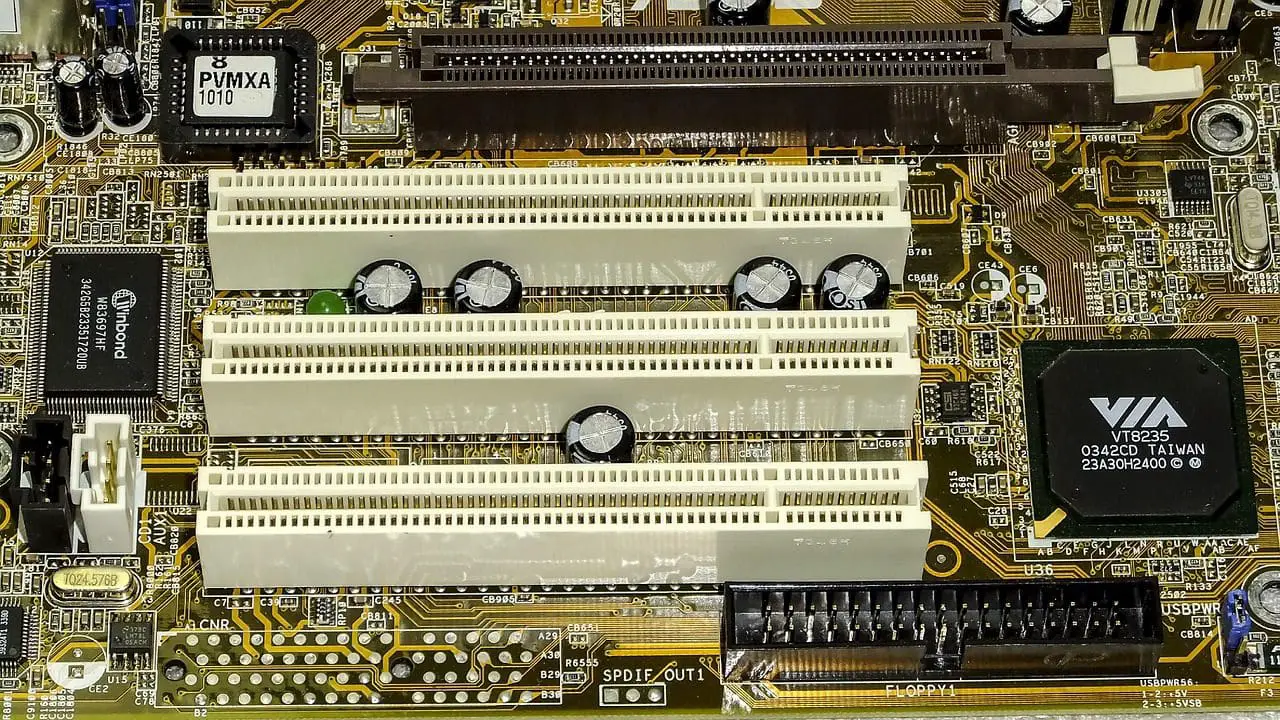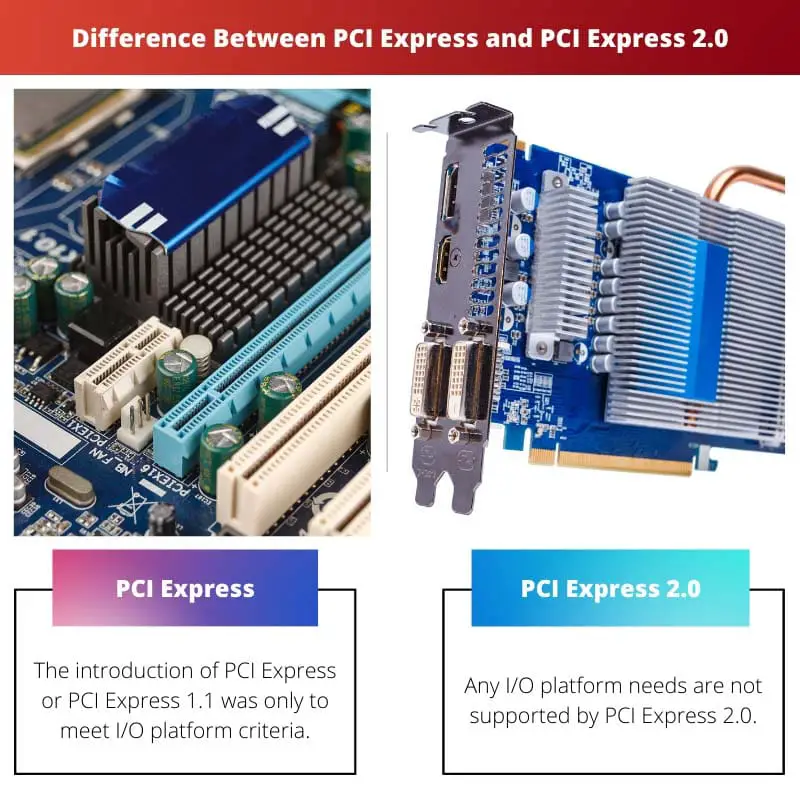Every day, technology advances. As a result, it’s critical to keep up with current events and work properly. PCI stands for Peripheral Component Interconnect and is a bus type.
Its major aim is to expand the computer’s capabilities by allowing external devices to connect to it. PCI evolved into PCI Express and then to PCI Express 2.0, which is a more advanced, improved, and expanded version as technology advances.
Key Takeaways
- PCI Express is a standard for connecting computer peripherals, while PCI Express 2.0 is an updated version of the same standard.
- PCI Express 2.0 offers twice the bandwidth of the original PCI Express standard, allowing for faster data transfer rates and better performance.
- PCI Express 2.0 is backwards compatible with the original PCI Express standard, meaning devices designed for the original standard will work with a PCI Express 2.0 slot.
PCI Express vs PCI Express 2.0
PCI Express (PCIe) is a high-speed serial computer expansion bus standard used to connect various devices to a computer’s motherboard. PCI Express 2.0 is a revision of the original PCIe specification that was released in 2007. It doubles the transfer rate of the original PCIe 1.0 specification.

Any graphics-intensive application is not supported by PCI Express. PCI Express’ capacity was half that of PCI Express 2.0, with a per-lane throughput of 250 megabits per second.
PCI Express slots can only handle 75 watts as most. The slot’s power limits cannot be changed using PCI Express. PCI Express does not have all of the functionality that PCI Express 2.0 has to offer. Signalling is slower with PCI Express than with PCI.
Graphics-rich applications can be supported with PCI Express 2.0. PCI Express 2.0 provides twice as much bandwidth as PCI Express. PCI Express 2.0 offers 500 MB per second per lane performance.
PCI Express 2.0 slots can provide a maximum of 150 watts of power. PCI Express 2.0 has the capability of altering the slot’s power constraints. PCI Express 2.0 is significantly faster than previous PCI Express versions in terms of signalling.
Comparison Table
| Parameters of Comparison | PCI Express | PCI Express 2.0 |
|---|---|---|
| I/O Platform Requirements | Supports I/O platform requirements. | Does not support I/O platform requirements. |
| Enriched graphics application | Does not support enriched graphics application. | Supports enriched graphics applications. |
| Bandwidth offered | Half of the bandwidth of PCI Express 2.0. | Double the bandwidth of PCI Express. |
| Per-lane Throughput | 250 MB per second. | 500 MB per second. |
| Slots Maximum limit | 75 watts | 150 watts |
| Power limit change | Does not have the potential. | Possesses the potential to change. |
| Features offered | Does not possess all the features offered by PCI Express 2.0. | Possesses all the features that are offered by PCI Express. |
| Signalling | Provides slower signalling. | Provides faster signalling. |
What is PCI Express?
The introduction of PCI Express or PCI Express 1.1 was only to meet I/O platform criteria. PCI Express does not support any graphics-intensive applications. PCI Express featured half the bandwidth of PCI Express 2.0, with a per-lane throughput of 250 megabits per second.
PCI Express is also commonly known as PCI Express 1.1. This specification was introduced in 2004 by Intel. These are used primarily for components of the motherboard, including memory, storage and graphics.
PCI Express got its name according to the work it handles. It handles all the connections regarding non-core components having a point to point connections.
The maximum power that PCI Express slots can handle is only 75 watts. PCI Express cannot adjust the slot’s power constraints. PCI Express does not have all of the functionality that PCI Express 2.0 offers. Signalling is a little slower with PCI Express.

What is PCI Express 2.0?
Any I/O platform needs are not supported by PCI Express 2.0. Graphics-enhanced applications are supported by PCI Express 2.0. PCI Express 2.0 provides twice the bandwidth of PCI Express.
PCI Express 2.0 has a per-lane throughput of 500 megabits per second. PCI Express 2.0 has been in existence since its launch in 2007.
It was introduced as an advanced version of PCI Express 1.1. This new version possesses recent functional engagements. PCI Express 2.0 Standard has its greatest advantage as it is fully compatible with PCI Express.
This speciation offers much faster signalling, which has doubled from 2.5GT per second to 5GT per second. This serves as highly beneficial for applications using high bandwidth.
The maximum power that PCI Express 2.0 slots can handle is 150 watts. PCI Express 2.0 can alter the slot’s power restrictions. PCI Express 2.0 has all of the functionality that PCI Express has to offer. PCI Express 2.0 offers significantly quicker signalling than all previous PCI Express versions.

Main Differences Between PCI Express and PCI Express 2.0
- The sole reason behind the introduction of PCI Express or PCI Express 1.1 was to meet the I/O platform requirements. On the other hand, PCI Express 2.0 does not support any kind of I/O platform requirements.
- PCI Express does not support any kind of application that is enriched with graphics. On the other hand, PCI Express 2.0 supports applications that are graphics enriched.
- The bandwidth offered by PCI Express was half the bandwidth offered by PCI Express 2.0. On the other hand, PCI Express 2.0 offers bandwidth that is double the bandwidth offered by PCI Express.
- 250 MB per second is the per-lane throughput offered by PCI Express. On the other hand, 500 MB per second is the per-lane throughput offered by PCI Express 2.0.
- The maximum limit that the slots of PCI Express can sustain is only 75 watts. On the other hand, the maximum limit that the slots of PCI Express 2.0 can sustain is 150 watts.
- PCI Express does not have the potential to change the power limits of the slot. On the other hand, PCI Express 2.0 can change the slot’s power limits.
- PCI Express does not possess all the features offered by PCI Express 2.0. On the other hand, PCI Express 2.0 possesses all the features that are offered by PCI Express.
- PCI Express provides comparatively slower signalling. On the other hand, PCI Express 2.0 provides comparatively faster signalling than all the other existing PCI Express versions.

- https://ieeexplore.ieee.org/abstract/document/1231473/
- https://books.google.com/books?hl=en&lr=&id=IA-5TR1RgXQC&oi=fnd&pg=PR37&dq=pci+express&ots=RlJUhzVJrj&sig=rauhUygJgNRuJeV6cfdQ4WKKmTc